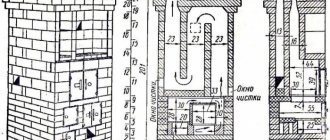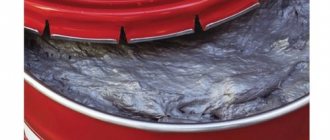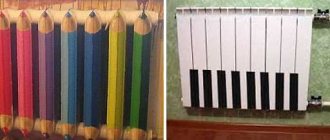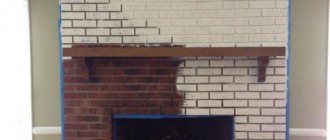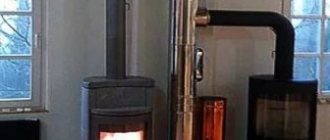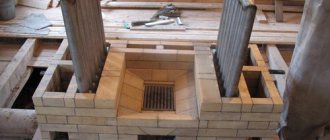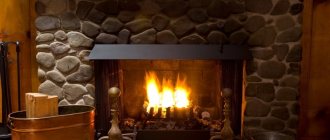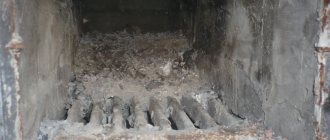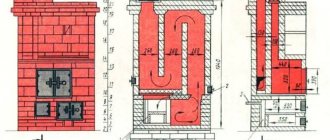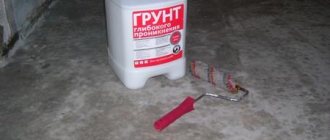Why paint stoves and fireplaces?
A brick or plastered stove, as well as fireplaces, are treated with varnish or paint not only to preserve their visual appeal. The coating allows you to extend their service life and avoid aging of individual structural elements of heating devices.
Brickwork made from a material that is not uniform in color can be given an attractive appearance by coating it with heat-resistant paint. In this case, you can use several shades of the product at once. You can emphasize the attractiveness of finishing masonry by using colorless varnish. It gives brightness to ceramic materials.
It is advisable to paint a stone heating device in various cases:
- to protect the stove surface from household pollution, and things from traces of brick dust;
- to facilitate daily maintenance of the heating device;
- to bring the appearance of the stove in line with the overall interior design of the room.
Use of heat-resistant paint - how to paint stoves, radiators, etc.
Boilers, stoves, fireplaces, pipes, radiators, chimneys - anything that is heated in a heating system often needs painting. But only heat-resistant (heat-resistant) paints should be used here. What are their features, what types are most popular and what is better to choose and then use...
Heat resistance and fire protection - different qualities
On sale you can find both heat-resistant paints and those that protect against fire. These are different finishing materials and are not interchangeable.
- Heat-resistant paints form a durable layer that, when heated to a high temperature, does not burn and maintains contact with the heated surface.
- Fire-retardant paints, when exposed to flame, foam, forming an ash-rich, non-flammable porous layer that effectively insulates the structure and protects it from fire.
What temperature does it heat up to?
Different heating system components that require heat-resistant paint can reach different temperatures. Here are typical values to expect.
- Radiators and water heating pipes - usually up to 90 degrees, maximum for a short time - up to 120 degrees C.
- Chimneys, elements of stoves, boilers adjacent to burners, ash pans, ovens - up to 200 degrees C.
- Metal shells of boilers, combustion chambers, hobs - normally up to 350 degrees C, maximum - up to 500 degrees C.
Heat-resistant paint is selected in accordance with these temperatures. What temperature can it withstand?
Types of paints and their heat resistance
- Paints based on drying oils and oils. They begin to deteriorate when reaching 90 degrees C. The same applies to simple alkyd pentaphthalic enamels (PF). Complete destruction at 150 - 180 degrees. C. Similar types of oil paints (based on petroleum products) are not allowed for use in heating systems.
- Heat-resistant alkyd compositions. They differ from the previous ones in increased heat resistance, with an operating temperature of 90 degrees, up to 120 degrees. The marking contains the number 8.
- Acrylic compositions. They can behave stably up to a temperature of 120 degrees C.
- Paints with epoxy resin. The binder in relatively heat-resistant paints can be epoxy resin, and the filler is often metal dust. Withstands heating usually up to 300 degrees C, which needs to be clarified in the characteristics of a particular product, since the spread can be significant.
- Organosilicon enamels. This type of heat-resistant paint may have other names - “silicone”, “polymer”. Typically, such products contain silicone resins as a binder, but there are polymer additives and silicon derivatives. Fillers are metal powder or graphite, which significantly increase heat resistance and determine color. Aluminum powder (serebryanka) - “silver”, maybe with the addition of brass dust to obtain a golden tint or bronze, copper... The main thing is that these are heat-resistant enamels that can withstand heating, usually at least +500 degrees C.
What paints are used when?
Heating pipes, radiators, cold chimneys, non-heated parts of fireplaces, stoves (up to +100 degrees C) can be painted with simple alkyd paints (increased heat resistance) or acrylic compounds. But in any case, when choosing paints for a heating system, you must strictly adhere to the manufacturer’s recommendations, first of all paying attention to the possibility of using it indoors specifically when heating. The choice of paints in the “radiator” category is huge; purchasing a reliable product is not a problem.
Epoxy compounds may be suitable for the outer parts of the stove, chimneys, etc. which often and significantly change their temperature, but do not heat up to high temperatures - the usual area of application is up to +250 degrees C.
Painting of boilers, furnaces made of metal and stone heated to high temperatures is carried out with silicone paints with increased heat resistance up to +500 degrees C.
General rules for the use of heat-resistant paints
- The surface to be painted must be cool.
- All peelings and dust are removed, cleaned with metal brushes, brushes, and washed.
- Degreasing is done with solvents. For metal, additional cleaning is performed to a shine and treatment with phosphoric (rust-removing) acid.
- Heat-resistant paint is applied in accordance with the manufacturer's recommendations. Often a preliminary application of a primer of appropriate quality is required. For low-temperature options, for example, acrylic primer is recommended...
What was painted before?
For many centuries, the traditional way to paint stoves in homes was to coat them with lime. It was diluted with water and applied to the surface. To improve the adhesion of the lime mortar to the ceramics, a small amount of salt was poured into it. The plastered and lime-coated stove was made snow-white by adding blue to the solution. This method of dyeing continues to be used today, primarily in rural areas.
Standard kiln covered with lime.
Another option for painting stoves is to use homemade varnish. It was prepared from a mixture of egg whites and milk in a 1:1 ratio. To give the coating a natural reddish ceramic tint, brick dust was added to the composition. To avoid staining clothes when they come into contact with the oven, a layer of protein was applied over the varnish.
What is used today
Modern paint and varnish compositions that are exposed to thermal effects can withstand heating up to +350…+400 ºС. The flame temperature in the firebox where the wood burns reaches +450 ºС. When the fuel is coal, it increases to +1000 ºС.
Pay attention to: Thermal insulation paint: composition and characteristics, scope of application and popular manufacturers
The outer surface of the stove does not heat up as much as the firebox. However, to cover it you should choose heat-resistant paint or varnish that can withstand heating up to +400...+550 ºС. Heat-resistant paints and varnishes are manufactured for different purposes and different surfaces. Manufacturers indicate on the packaging the temperature resistance of the coating, as well as the type of surface for which it is intended: brick or metal.
The range of fire-resistant compounds includes coatings of various shades. Colorless varnishes preserve the natural appearance of stone or brick for a long time.
Natural drying oil
Coating with natural drying oil does not change the natural shade of the brick, but makes it darker. The peculiarity of drying oil is that a heating device coated with this composition can only be heated for a limited time. Therefore, it is not suitable for stoves located in residential premises and is used to cover heaters installed in the bathhouse.
Organosilicon paint
The basis for the production of silicone coatings for stoves or fireplaces are organic resins. These paints and varnishes have good adhesion to surfaces of various textures. They form a durable, moisture-resistant coating that can withstand up to 250 heating-cooling cycles. The disadvantage of organosilicon compositions is the lack of color solutions, which is due to the chemical properties of these coatings.
Natural drying oil for stoves.
Alkyd based varnish
Alkyd paints and varnishes can be used for brick surfaces that do not heat above +100 ºС. Manufacturers of the compositions introduce into them marble or granite dust, components with antifungal and fire-fighting properties. The disadvantage of alkyd compositions is their low elasticity. Varnishes are not able to withstand the constant thermal expansion of ceramics, so the coating requires annual renewal due to the appearance of small cracks on its surface.
Heat resistant paint
Painting of brick or plaster-covered stoves, chimneys and fireplaces is carried out with heat-resistant paint that can withstand heating up to +200…+400 ºС. Varnishes that can withstand high temperatures should also be included in this category. Their operating temperature is +250…+450 ºС.
Heat-resistant compounds not only withstand prolonged exposure to high temperatures, but they are safe for humans because they do not emit hazardous substances when heated. Heat-resistant coatings do not affect the heat exchange between the heating device and the room air, are resistant to detergents, and are elastic. To provide the stove surface with a uniform, uniform coating, you need to apply 2-3 layers of paint.
Oven before and after painting.
Features of aerosols
Producing paint in cans is a very successful decision by the manufacturer, since it is this fact that allows you to evenly paint all kinds of cracks and hard-to-reach gaps.
When choosing heat-resistant aerosol paint, you should pay attention to the characteristics, which may also influence the purchasing decision.
The main thing you should focus on is the maximum temperature for which this product is designed. Heat-resistant aerosol paint can withstand only a certain temperature regime, which is indicated by the manufacturer on the can.
In stores you can find a considerable amount of heat-resistant metal paints that are not designed for direct contact with fire. One should also distinguish between constant heating and short-term heating. The constant heating temperature is usually noticeably lower.
There are certain requirements for the surface to be coated. Sometimes, for a high-quality result, before painting it should be primed, then apply heat-resistant spray paint, holding the can at a distance of about 25 cm from the surface and shaking occasionally.
Priming will prevent peeling of the top enamel due to exposure to high temperatures.
However, some brands do not require a primer. This is indicated in the instructions, so before using any paint, you must carefully study the manufacturer's recommendations.
For example, the instructions for heat-resistant enamel in the High Heat can say: “it is not recommended to prime the surface.” You just need to clean it of the old paint layer and rust, wash it with soapy water and dry it, or clean it with sandpaper and degrease it with a solvent.
If you have any doubts about the method of using the spray can, you can clarify all questions with your sales consultant or distributor. Most companies provide online consultations.
Heat-resistant paints retain increased ductility even after complete drying. When in contact with fire, a painted metal surface can increase or expand, and its plasticity allows the applied layer to be maintained in its original state without peeling or delamination.
What is better to choose
To preserve the appearance of stoves or fireplaces with a stone design, it is advisable to use a heat-resistant transparent varnish. It will emphasize the surface texture and color of the material, natural or artificial.
The coating on a small surface area can be applied using paint in an aerosol can. It dries quickly and does not require any skills in working with paints and varnishes. The spray is easy to apply to hard-to-reach and uneven surfaces. Compositions produced in the form of aerosols do not require pre-treatment of the materials being painted.
If at your dacha there is a need to paint a stove located outside, the best choice would be paint labeled KO-8101. It is resistant to weather conditions and can be used even in winter.
Pay attention to: Comparative analysis: water-dispersion and water-emulsion composition.
The use of latex water-based paints with heat-resistant characteristics makes it possible to impart water-repellent properties to the surface of the stove. It is advisable to use such a water-based coating in the kitchen.
Types of heat-resistant paints
When applied to the surface, heat-resistant enamels and fireplace paints dry and create a protective film on the surface. Depending on the composition, they may additionally be endowed with the ability to prevent corrosion and repel moisture.
There are several types of dyes:
- Polyurethane paints. They are suitable for all types of ovens, create a shiny surface and dry quickly;
Polyurethane paint is suitable for all types of ovens - Water-based latex mixtures. They are intended for bath-type stoves or for those installed outdoors;
- Water-based acrylic paints. Such paints cannot be used for surfaces with high humidity, but they protect metal fireplaces and stoves from rust;
- Enamels and paints with silicon filling. These are the most universal representatives of heat-resistant materials (for stoves made of stone, brick, metal).
What to look for when choosing
When choosing a paint coating for heating devices, pay attention not only to the characteristics of the composition itself, but also to the desired effect. The brick surface of a stove or fireplace can be treated with either paint or varnish. Each option has its own advantages.
Carefully executed masonry has an attractive appearance and fits well into the design of the room. In this case, it is not advisable to cover it with paint - it is enough to treat the brick with a varnish that preserves the pattern and texture of the material. It dries quickly and can be applied immediately to the entire surface of the heating device.
When covering with paint, it is also possible to preserve the pattern of the brickwork. To do this, you will have to use a stencil or cover the seams so that the paint layer lies only on the bricks. In this case, it is advisable to treat the masonry seams with a high-temperature sealant to prevent them from spilling out. If there is no need to preserve the surface pattern, the paint can be applied in a continuous layer, covering both the stone and the seams at once.
Special attention should be paid to painting the stove in a bathhouse or sauna. In this case, the composition must withstand the high humidity that is maintained in the room. For these purposes, black enamels are often used, which are suitable for both ceramics and metal surfaces.
Popular paint brands
Elcon heat-resistant enamel.
To paint a brick fireplace or stove in your home, you can use varnish from the Russian brand Elcon. With its help it is easy to give the stone a matte or semi-glossy look. The effect is determined by the number of layers applied. The varnish is available in aerosol cans. One is enough to treat 2 m² of surface. The coating dries in 3 hours; complete polymerization of the varnish requires 3 days while maintaining room temperature in the room.
Please note: Two in one: beauty and protection - fire retardant paint
Elcon heat-resistant paint is suitable for machine tinting. The black composition has the greatest heat resistance. It can withstand temperatures up to +1000 °C. Pigmentation of the paint material reduces its heat resistance characteristics. After tinting, the paints can be used at temperatures up to +600 °C. They can be used to coat ceramic surfaces, metal boilers and fireplace grates. Paint consumption is determined by the number of layers applied and the structure of the surface being treated.
Russian Cetra KO-85 varnish is available in cans. A 0.8 liter capacity is enough to cover 5 m² of surface in one layer. The varnish can withstand temperatures of +250 °C. Since the composition is made on the basis of solvents and synthetic resins, it has a pungent odor that disappears after heat-hardening the painted surface. When working with this varnish, it is necessary to ensure good ventilation of the room.
Technology of coating products with heat-resistant paint
When applying heat-resistant paints, use a brush, roller or spray gun. If you choose an aerosol spray for painting, no additional tools are needed. Most heat-resistant paints and varnishes do not require additional surface preparation. It is enough to remove dirt from it, degrease it, and then cover it with a layer of primer.
To paint a brick stove in a house, heat-resistant paint must be applied in 2-3 layers. Coating the surface with a new layer is possible only when the previous one is completely dry. The correct choice of composition and adherence to the technology of its application is a guarantee that the paint coating will remain on the ceramic surface for 5-7 years.
Read further:
Fire retardant paint: principle of operation and scope of application, types of paint for metal and wood, the best manufacturers
Scope and properties of ceramic paint
Bathroom paint: types and characteristics of paint and varnish compositions, tips for choosing
Forging paint for metal
Alkyd paint for wood for exterior use: features of the composition and rules for its use
Advantages and disadvantages
Spray paints have both advantages and disadvantages that you need to be aware of that may influence your final choice.
The advantages include:
- ease of use of the aerosol in a can, since the composition is already ready for application to the surface and does not require any additional preparation steps;
- when painting, it easily copes with hard-to-reach areas;
- does not require additional tools and devices, except for a mask for the worker;
- dries in a short period of time and is not exposed to direct sunlight;
- the aerosol has good adhesion properties;
- the remaining composition in the can does not dry out;
- heat-resistant paint is often odorless or light, not concentrated;
- allows you to paint in several shades at the same time with a smooth transition between colors.
In addition to the advantages, there are also disadvantages that cannot be called too significant. So, when purchasing this product, you should pay attention to the inability to mix different colors.
When applying an aerosol without proper experience, you must be prepared for the appearance of drips. To get straight lines, use stencils. Paints in spray cans do not have the ability to change the consistency of the composition.
For painting metal surfaces that are susceptible to high temperature conditions, the use of heat-resistant paints in cylinders is advisable.
Working with aerosol outdoors is not always convenient; you need to control weather conditions and gusts of wind, which, when spraying paint, can scatter it in different directions.
When compared with similar products in another form of release, the price is justified by the quality of the coating and durability of use. This product is famous for its good adhesion to the surface being coated.
By following the instructions and applying the paint in accordance with all the rules, you will ensure a service life of at least ten years.
